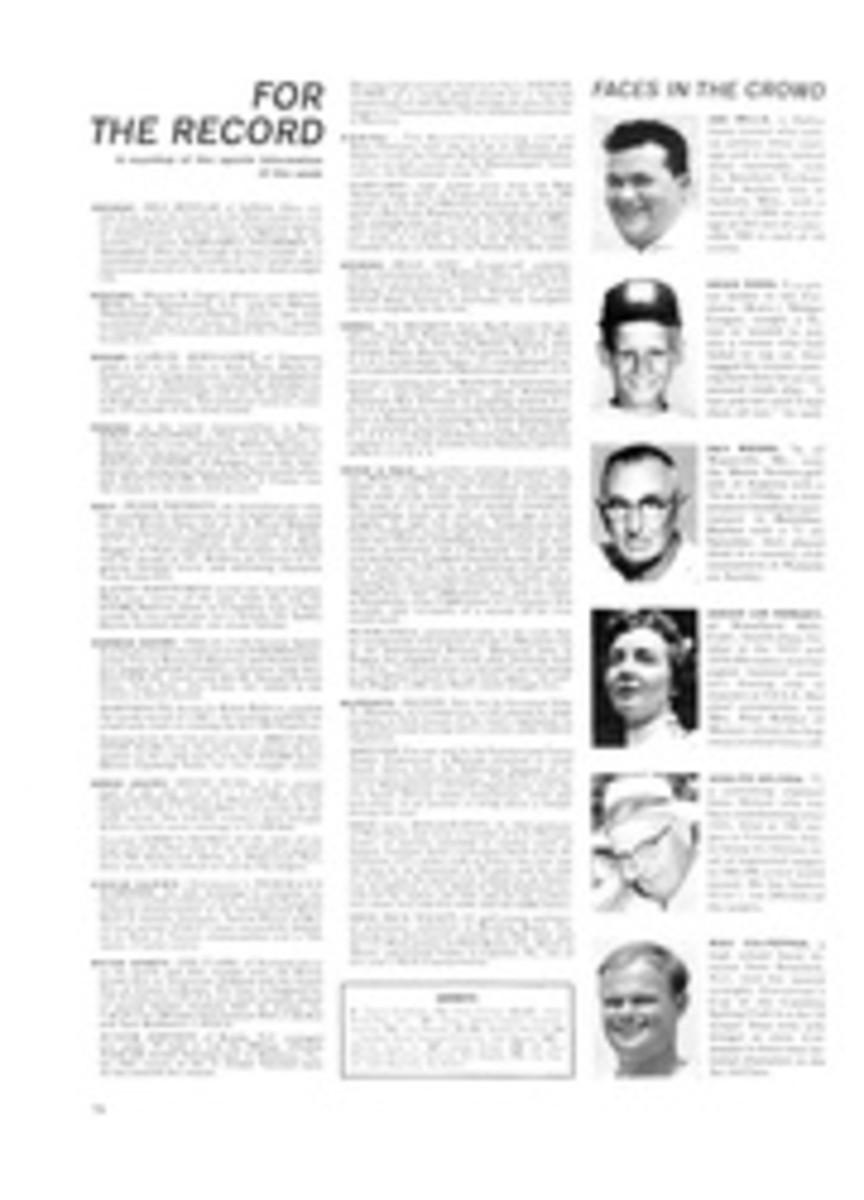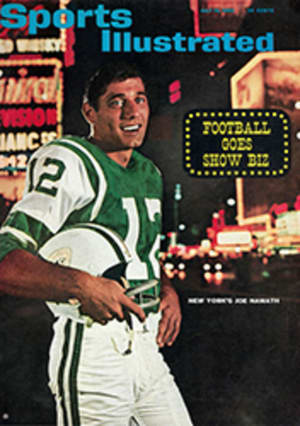
Treating a filly with finesse
In the ordinary course of things, the homely girl never gets a second look. But that's not true in trotting, and last week a dowdy brunette with knobby legs and stringy hair was getting more second looks on Main Street in Goshen, N.Y. than Liz Taylor would have with all her 72 suitcases.
At the town's old clay track Armbro Flight, a broad-beamed 3-year-old, wriggled her way into her harness and put on a show in the Coaching Club Oaks that had Grand Circuit horsemen wondering if she might not be girl enough to hold off a field of boys in The Hambletonian come September. Twelve years ago her dam, Helicopter, beat the colts in that classic event, and harness racing is a sport where no girl ever takes back.
One of the distinctive facts of trotting life is that mares have raced to more world-record miles than colts and geldings combined. The fair sex has also fared well in the The Hambletonian, winning 10 of 39, an astonishing statistic when compared with filly performances in equivalent Thoroughbred classics. Only six fillies have beaten the colts in 186 runnings of the Epsom Derby and just one, Regret in 1915, has managed to win a Kentucky Derby. The list of renowned trotting mares and their achievements is extraordinary. There was the bobtailed Flora Temple, who set six world records, the last when she was a grandmotherly 14; Goldsmith Maid, winner of 332 dashes and out of the money only once; and Lou Dillon, the mare who never learned to trot until she was frightened by a dog but—perhaps thinking she still was being chased—became the first trotter ever to go the mile in under two minutes.
Horsemen, offer several explanations of why Standardbred mares perform so well. It is argued that their cooler blood makes them phlegmatic, hence easier to train than hot and fretful Thoroughbreds. And it is certainly true that they have rugged physiques, which enable them to clip-clop mile after mile on cementlike tracks while breathing no harder than Julie London exhaling a Marlboro commercial. But most important of all, Standardbred fillies are subjected to the same relentless training regimen as colts, and harness horsemen believe that because more is asked of their girls than of the Thoroughbreds, more is forthcoming.
Armbro Flight's own trainer, Joe O'Brien, says, "Long ago women worked in the fields at hard labor. They worked alongside men, and they had to be as tough and strong. But look what happened. Over a period of time women had to work less, and they changed. The modern ones never work hard. If they do, it's at a stenographer's job or some such thing, not physical work all day long. So they have become comparatively soft. Well, this is fine for women, but the same thing has happened with Thoroughbreds. The Thoroughbred people have had this idea that fillies could not work as hard as colts. They would not start them against colts because they thought they had no chance. They developed a standard kid-glove way of training a filly. Since generation after generation of Thoroughbred mares has been bred in this dainty image and has been pampered, these animals have really become soft. But Standardbred mares are different."
Theorist O'Brien's Armbro Flight is decidedly different, not soft at all, and after a rather indolent beginning she has become every bit a working girl. She has won 25 of her 31 races, and the final heat of the Coaching Club at Goshen marked her 13th straight victory.
At 16 hands 3 inches she was big and gawky and slow to develop. In fact, it was not until late last summer that O'Brien recognized the trotting talent hidden by her easygoing temperament. "She has never been overly ambitious," O'Brien said last week. "She would do what you wanted, but you had to ask her." While she was a languid 2-year-old O'Brien did not ask her, and most of Armbro Flight's defeats came in the first few races of her career.
But once O'Brien suspected that the chocolate-coated filly had talent, the easy life was at an end. O'Brien mapped out a long-range plan to develop both her ego and her power of positive thinking. "I decided to use the kind of strategy on her," O'Brien recalls, "that I used on Shadow Wave in 1958. I never started him against the top-class horses until the Little Brown Jug. I'd put him in the minor races where the purse was next to zero and the competition even less. He could win without being fully extended, and he was in a fine frame of mind by Jug time. He thought there wasn't a horse in the world that could beat him. He won in straight heats.
"I'm trying to do the same thing with Armbro Flight. I've put her in the slower filly races, and I don't plan to start her against the colts until The Hambletonian. If she can keep winning every week without being gutted, even if the competition isn't much and the times aren't great, I'll be pleased. She'll come into the Hambletonian just right. A horse develops a wonderful fighting spirit winning week after week."
There is nothing wrong with Armbro Flight's fighting spirit right now. At Goshen she scored easy victories in both heats. In the first she had the outside post position, which meant there were nine erratic fillies between her and the rail. At the start the nine took off in every direction like so many housewives turned loose in Macy's on sale day. Armbro skirted the field and, down the back-stretch of the half-mile track, she took the lead. She trotted home three lengths in front.
An hour and a half later the girls came back on the track for the decisive second heat, head numbers bobbing between their ears like bonnets and their hooves clad in white bell boots. They paraded in single file, tossing manes and glances here and there, looking like so many hopefuls in a beauty contest in East Alton, Ill. Armbro Flight, her forelock in a pigtail, kept her best act for later.
She sped away from the starting gale and cut out the first half mile in 1:01[1/5] Far behind, another filly, Frosty Song, broke stride and began to gallop. Suddenly she fell over Comanche Newport, who was passing her on the inside. Both fillies went down.
O'Brien turned into the backstretch the second time around and, seeing the wrecked sulkies and a tangle of horses and men, he slowed down. Armbro Flight swung wide to avoid the trouble, but as she did a buxom lady—this one human—astride a white saddle horse came cantering up the track heading toward the accident and directly at O'Brien. Armbro Flight bolted—first to the inside, then to the outside. She thrashed with her hind legs at the sulky, struck a tire with her hoof and blew it out. Remarkably, she stayed on gait and, although the accident momentarily cost her the lead, she regained it on the final turn and won in 2:03[2/5].
O'Brien was as shaken as his filly. He walked around her as she cooled out in Goshen's willow-shaded paddock, his dark-blue eyes searching for an injury. There was none. He wrapped the filly in orange woolen blankets and rubbed her pig-tailed brow. More and more she was looking like a fair challenger to the Hambletonian favorite, Noble Victory.
"I think I could have beaten that colt last year at Indianapolis," Joe said. "I was four lengths in front and Stanley Dancer had him way back in the pack. I hadn't used my filly at all, and I was just sitting there waiting until he came at me. I knew just what to do. Then I saw a double-fold of newspaper blowing down the track at us. I couldn't avoid it. The filly reached out and pawed at it, and of course she broke stride. By the time she got back on gait, Dancer was long gone and the best I could do was second."
But that was last year. This September there should be no newspapers at Du Quoin. Heaven will protect the working girl.
PHOTO
HER LONG MANE FLYING, ARMBRO FLIGHT TROTS POWERFULLY TO WIN AT GOSHEN

